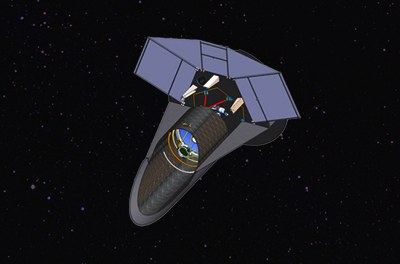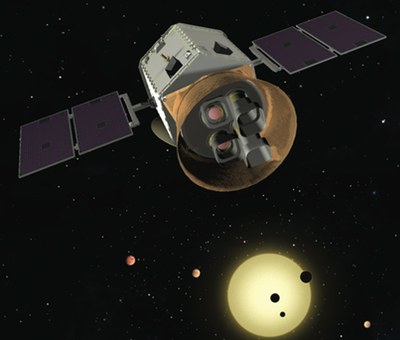Exoplanet explorersby Jeff Foust
|
| “This mission really is not about statistics. It’s really about finding excellent candidates for followup work,” Ricker said of TESS. “These will be the best targets for humanity for a long time to come.” |
TESS, the Transiting Exoplanet Survey Satellite, is the more Kepler-like of the two selected exoplanet missions. TESS will look for exoplanet transits, events when a planet passes in front of its star, causing a minute but periodic dimming of that star. However, unlike Kepler, which looks at a single region of the sky, TESS will perform an all-sky survey, focusing on stars within about 200 light-years of the Earth and identifying nearby exoplanets for followup observations.
MIT’s George Ricker, the principal investigator of TESS, says that TESS should be seen as complementary to Kepler. “The questions that are being answered scientifically by TESS and Kepler are somewhat different,” he said in a presentation about the mission at the latest ExoPAG meeting, held over the weekend in Austin, Texas, in advance of this week’s meeting of the American Astronomical Society (AAS) there. Kepler, he said, is designed to measure the frequency of Earth analogues around other stars, while TESS is attempting to identify those nearby stars with rocky exoplanets, including Earth-sized and so-called “super Earth” exoplanets. “That’s really the key idea behind the mission.”
TESS, if selected, would launch by 2016 into a highly elliptical orbit, operating for at least two years. Equipped with four wide-field cameras, the spacecraft would be able to observe potentially hundreds of thousands of stars, looking for those telltale periodic dips in brightness caused by transiting exoplanets. Ricker noted that this Explorer competition is not the first time they proposed TESS; the mission was also selected for phase A study for NASA’s Small Explorer (SMEX) program in 2008, but ultimately not chosen for development. “We’ve had a chance to refine the mission concept and simplify it in many ways” since then, he said.
At the ExoPAG meeting, some wondered how many potential exoplanets TESS might miss because, unlike Kepler, it won’t be making continuous observations of the sky. Ricker didn’t give a specific answer, saying it would be a relatively complex calculation, but added that making a comprehensive examination all nearby stars wasn’t the point of the mission. “This mission really is not about statistics. It’s really about finding excellent candidates for followup work,” he said. “These will be the best targets for humanity for a long time to come.”
While TESS seeks to find other exoplanets, FINESSE—the Fast INfrared Exoplanet Spectroscopic Survey Explorer—proposes to better characterize the ones already found. That spacecraft’s main instrument will be a near-infrared spectrometer, designed to detect the presence in exoplanet atmospheres of key molecules, including water, methane, carbon monoxide, and carbon dioxide.
“FINESSE’s job is really to explore new worlds around other stars, and it would be the first mission really dedicated to characterizing the atmospheres of exoplanets in detail,” said JPL’s Mark Swain, the principal investigator for the mission, at the ExoPAG meeting, putting the mission in a much broader context. “FINESSE is the next step in humankind’s journey of understanding our place in the cosmos.”
The spacecraft, launched into a sun-synchronous low Earth orbit designed to maximize its thermal stability, will look at 200 exoplanets, ranging from Jupiter-sized worlds down to super-Earths. FINESSE will collect spectra at multiple points in each exoplanet’s orbit to try and discern not just each planet’s atmospheric composition but also any day-night variations. “That opens up the possibility of a detailed characterization and maybe even start to probe some of the atmospheric flow characteristics that some people have modeled,” Swain said.
| “FINESSE’s job is really to explore new worlds around other stars, and it would be the first mission really dedicated to characterizing the atmospheres of exoplanets in detail,” said Swain. |
What sets FINESSE apart from other efforts to collect exoplanet spectra, Swain said, is its promised combination of spectroscopic coverage and stability. The former, he said, will allow it to explore the key spectral bands in the atmospheres of planets orbiting a broad range of stars, while the latter will make it easier for scientists to analyze and interpret those spectra. “With a purpose-built, optimized observatory, you do have the opportunity to design it to do one thing really, really well,” he said.
While TESS and FINESSE received funding to perform their phase A studies in hopes of being selected for full-scale development next year, a third exoplanet mission won funding instead to work on technology development to make it feasible down the road. The EXoplanetary Circumstellar Environments and Disk Explorer, or EXCEDE, seeks to understand the dust disks that surround other stars and their links to the formation of exoplanetary systems.
Glenn Schneider of the University of Arizona’s Steward Observatory kicked off his ExoPAG talk on EXCEDE by showing an image of the zodiacal light visible in the night sky, caused by sunlight scattering off of dust in our solar system. “This is what we’re trying to observe in exoplanetary systems, which is the noise and the dirt that most planetary people are trying to get rid of,” he said. While that dust can provide insights into the formation of planetary systems, its presence is also a cause for concern for some astronomers, who worry that high levels of exozodiacal dust could make it difficult or impossible for future missions to directly image exoplanets.
EXCEDE, if later selected, would study the amount of dust in exoplanet systems, including whether the dust levels could hinder future imaging efforts. The spacecraft would fly a relatively modest (0.7-meter) telescope on a small spacecraft in Earth orbit equipped with an active starlight suppression system, featuring a coronagraph and deformable mirror, that would block the star’s light as precisely as possible, enabling observations of the dust levels relatively close to the star. That system is the focus of the technology developing funding EXCEDE received from NASA in lieu of a phase A award.
The technology developed for EXCEDE, Schneider said, could later be adapted for use on larger exoplanet imaging missions, although the small telescope proposed for the mission can still do good science. “EXCEDE is a mission that fulfills a capability that we actually don’t have today,” Schneider said. “A large telescope isn’t needed to meet our science goals.”
 FINESSE features a near-infrared spectrograph that will allow astronomers to characterize the atmospheres of 200 exoplanets. (credit: JPL) |
Kepler seeks an extension
While TESS, FINESSE, and EXCEDE all propose to do new science in the exoplanet field, the Kepler mission, launched in March 2009, continues to return data that has enabled the discovery of more than 30 confirmed exoplanets. This has included, in just the last month, the discoveries of a planet in the habitable zone of a Sun-like star and the first Earth-sized planets (albeit not in their star’s habitable zone), a funding that got considerable, if mixed, media attention (see “Reporting Kepler 20e and 20f”, The Space Review, this issue.) In his presentation at the ExoPAG meeting, Kepler principal investigator Bill Borucki promised some “nice surprises” in a press conference Wednesday at the AAS meeting.
The Kepler data, which also includes more than 2,300 candidate exoplanets awaiting confirmation, is not without its challenges. One unforeseen issue scientists have encountered is unexpected variability in the Sun-like stars Kepler is observing. Prior to the mission scientists assumed that the majority of the stars they would observe would be at least as quiet as the Sun, which has a variability of about 10 parts per million (ppm) during the period of an exoplanet transit. Instead, they’ve found that the average variability is closer to 20 ppm, with many stars showing even much higher variation. That finding has puzzled scientists. “The Sun,” quipped Borucki, “is not a solar-like star.”
| Most of the stars being observed by Kepler are more variable that our Sun. “The Sun,” quipped Borucki, “is not a solar-like star.” |
That higher variability introduces more noise in the observations, making it more difficult to pick out an exoplanet transit. A solution to that problem, he said, is to extend the mission by as long as four years. If the mission stopped as planned after three and a half years—that is, late this year—Kepler would only be able to probe the habitable zones of M- and most K-class stars for exoplanets. Extending it by four years, he said, would allow Kepler to probe the habitable zones of brighter stars, including most G-class stars (like the Sun) and some F-class stars.
That extended mission is not automatic, though, even with the successes Kepler has achieved to date. Kepler is facing a “senior review” by NASA’s astrophysics division this spring, which will examine if the mission’s science is worth the expense of an extension. Borucki said that the project will submit a proposal next month for the senior review, and expects an answer in April.
That review has raised concerns about the mission’s future, though, with some going so far as to claim that Kepler is in danger of cancellation (see “An uncertain future for solar system exploration”, The Space Review, November 14, 2011). Doug Hudgins of NASA Headquarters dismissed those claims as “wild talk” during a presentation at the ExoPAG meeting. “Kepler is doing exactly what we expect every other operating astrophysics mission to do,” he said of the senior review process. “Kepler is not being picked on.”
While Kepler is not being singled out, it’s clear that, for NASA science programs in general, budgets will be tight for the foreseeable future given the overall fiscal pressures facing the space agency as well as the competition for funds by various other programs, including the large and expensive James Webb Space Telescope. NASA may ultimately fund a similar large, flagship-class mission devoted to exoplanet imaging and other science, but for now, some of the best prospects for advancing our knowledge of the number and characteristics of these worlds may come from much smaller missions.
